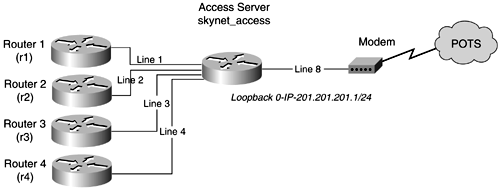Lab 6: Configuring Remote Access to the Lab-Part I
| < Free Open Study > |
Lab 6: Configuring Remote Access to the Lab ”Part IPractical ScenarioAttaching a modem to an auxiliary port or an asynchronous line provides a useful out-of- band method of management for routers and switches. You can provide a complete "configuration safety net" for your network with the placement of an access server at a central site. The access server would connect the console ports of all the routers at the central site; when combined with an analog modem, this provides a reliable method of access to your network. Lab ExerciseThis is the final lab of Chapter 1, and it serves as the springboard for all the other labs in this text. From this point on, you use this access server to configure the routers in the lab. To further enhance access to the lab, you add a modem to the last asynchronous port on the access server. This device serves as a key device in modeling some of the most complex internetworks known today. Therefore, the name Skynet is used to give the access server and models some character. Lab Objectives
Equipment Needed
Physical Layout and PrestagingAsynchronous connections should be connected as noted in Figure 1-18. |
| < Free Open Study > |
EAN: 2147483647
Pages: 283
